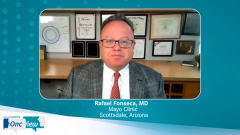
Treatment Strategies for Frail Patients and Patients with High-Risk Multiple Myeloma
Dr Fonseca discusses approaches for treating frail patients with multiple myeloma and those with high-risk disease.
Episodes in this series

Rafael Fonseca, MD:One of the challenges in the management of myeloma patients is that we see a significant fraction of patients that come with comorbidities or because of their advanced age, they're defined as being in this frail category. Individuals who have more difficulty without activities of daily living who may require assistance not only for transportation but sometimes even with mobility needs within their home. There is no question, and every clinician knows that these patients will be at significantly higher risk of complications that come out of drugs, and complications that we don't usually think too much about in those patients who fall more into this fit category.
There are a number of scales and systems by which frailty can be assessed. I think the reality is in the day-to-day practice in the clinic, it still remains somewhat a subjective determination but a pretty evident one, once we see patients. As I think about the myeloma populations, I really think about 3 large populations, about a third to 40% of patients who are younger and able to go through stem cell transplant and we steer them that way. There's about a third of patients who can clearly go through best-available therapy that can move forward with the combination as was presented by the MAIA regimen.
Then we have a third of patients that could still go through that combination but where one has to pay more attention because of the significant risk of toxicity associated with some of those drugs. And that is literally about a third of patients. Now for some of them, as I have mentioned before, we'll be better off starting with a doublet. But, we can think of well, is there a way by which we can address a better treatment in this patient population?
Dr. Facon published this year in leukemia, a study where they actually broke down the results for MAIA by this fitness and frail status. And they show that even within the frail there's an advantage of using the 3 drugs, which really brings us to the point that everything else being equal. I think it's reasonable to consider that 3-drug combination. I would point out to our audience that I think we have to be particularly careful with the dosing of both IMiDs [immunomodulatory drugs] as well as Dexamethasone. It is standard practice for me to start at that lower dose of Dexamethasone.
For patients who are frail, usually no more than 20 sometimes even lower than that and often times with a lower dose of an IMiDas well too because of the significant risk with the cytopenias and other side effects. And then again, these patients need careful monitoring so a well-integrated approach for monitoring surveillance, et cetera with the nursing team is critical. At the end of the day, what matters is for patients to stay on treatment. I think one of the problems, we have a person starts on a treatment and because of the toxicity they decide to go from that full treatment to nothing. Sometimes it's better to start with a treatment that would allow us to stay on therapy for longer even if it doesn't have the initial intensity of what we would have preferred to start, say in a fit patient.
An important consideration in the selection of therapies for myeloma is the identification of patients who have high-risk disease. Historically, we did this by looking at the classic genetic categories the [4;14], the [14;16] and minus 17. Over time things have evolved. We now consider chromosome-1 abnormalities in particular. I'd like to make emphasis on this, it should be amplification. Chromosome-1 abnormalities with one copy that is extra, those again are quite common. They can be seen up to 40% of my lung patients so they really should not be used to identify patients with high-risk disease. I would say I would only count that as high-risk if one has 4 copies or more.
We also have the advent of next-generation sequencing where we can see that the biallelic inactivation of P53 clearly is associated with a more aggressive disease. In fact, some studies suggest that if you just lose one copy but the other one is functional, you don't really have high-risk disease. So, this is an important piece of information. Then we also have the information that is derived from the gene expression profiling that has proven to be a very powerful mechanism by which you can identify high-risk patients.
It's also critical to remember that clinical features would also play into the identification of high-risk patients - patients who present with primary plasma cell leukemia, extramedullary disease, elevated LDH or the disease that is refractory to treatment would be patients where we would be worried about our ability to have durable disease control. Now a question that would follow that statement is OK, so if you can identify high-risk disease, what are the drugs that we use?
Historically, we've thought that it is protease inhibitors that should be used for high-risk patients. We have seen in a number of studies that protect some inhibitors can improve the outcomes of patients with a [4;14] and minus-17 [abnormality] which is great. But there is a question there that was never addressed and that is there is different biology between just having a translocation or having that P53 abnormality. So, I started to ask myself is it really that protease inhibitors are effective for high-risk disease or is it just that we're seeing a sub-optimal therapy from the comparison that we subject this process of inhibitors. And historically, when we talked about PIs on high-risk [patients], we were comparing Bortezomib with Dexamethasone versus Lenalidomide-Dexamethasone or Lenalidomide-Dexamethasone. I think it's very clear that IMiDs alone in combination with Dexamethasone are insufficient for high-risk disease.
Why do I say this? Several of the novel agents including Daratumumab, Selinexor, Isatuximab or perhaps even some of the immunotherapy approaches seem to have a beneficial effect on subsets of patients who have high-risk disease. In fact, Dr. Geary last year published a meta-analysis in general oncology where the analysis reveals that Daratumumab appears to have beneficial effects on patients with high-risk disease. While this is still unresolved, I think what we will probably end up seeing at the end is just that better treatments are better for high-risk disease patients. And that drugs like Daratumumab, Selinexor, Isatuximab will be effective in this patient population.
Transcript edited for clarity.
Newsletter
Stay up to date on recent advances in the multidisciplinary approach to cancer.



